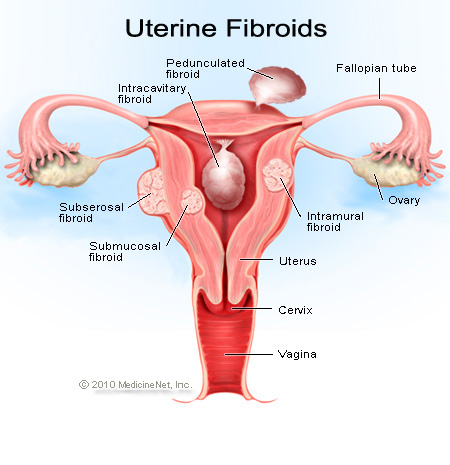What are fibroids?
Uterine fibroids (otherwise called fibromyomas, Leiomyomas or myomas) are developments made of smooth muscle cells that show up in the uterus during childbearing years. The developments are not threatening nor are they identified with growth, but rather they are delegated tumors. They are to a great degree basic and frequently go unnoticed by numerous ladies and regularly shrivel after menopause. Uterine fibroids happen all the more much of the time in dark ladies yet are never found in a lady less than 20 years of age.
The actual cause of development of uterine fibroid is unknown, but here is list of reason and risk factors affecting women with fibroid development.
- Hormone - the fibroids are linked with hormone Oestrogen and progesterone. These are found in ovaries, female reproductive system. These hormones stimulate the growth of uterine fibroids.
- Age - females of age 30 - 50 yrs are most expected to suffer from fibroids.
- Hereditary
- Pregnancy
Symptoms of Uterine Fibroid
- Vaginal Bleeding- very heavy bleeding from vagina is seen and it is very common symptom of fibroid. This leads to cause of anemia, headaches and weakness.
- Discomfort in Pelvic— large fibroids give a feeling of heaviness or pressure in their lower abdomen or pelvis. This causes discomfort and irritation. The increased size of uterus makes it difficult to lay face down, problem in bending.
- Pain in Pelvic— severe pain, it is very rarely seen. it happens when fibroid grows and degeneration starts. It develops with particular spot which expands within two three weeks.
- Bladder Problems- frequent urination is big problem.
- Discomfort or Pain With Sexual Intercourse
- Rectal Pressure
- Low Back Pain
Treatment for uterine fibroid
For small fibroids treatment is not needed as with time it will shrink and does not cause any discomfort. Treatment is necessary for those fibroids which cause trouble in normal life routine.
Before treatment it is essential to identify the correct cause and diagnose fibroid. This will need diagnosis methods. Some tests are
- Ultra sound diagnosis method
- MRI scans
- Saline Hysterosonography
- Hysteroscopy
Treatment includes surgical as well as medications. Surgical treatments are:
Myomectomy:
A myomectomy is a surgery to eliminate fibroids without damaging uterus and preserving it. For women those who want to have babies in the future, who have fibroid symptoms; myomectomy to remove fibroid is righteous option.
There are some types of operation. With tumor location and size of fibroids , surgeon may advise for
- An abdominal myomectomy
- A laparoscopic myomectomy
- A hysteroscopy myomectomy.
Hysterectomy:
It is operation in which uterus is removed. This is chosen by the women with quite higher age group resolving the symptoms and pain of fibroids. A disadvantage of this surgery is that women can no longer bear child, as uterus is eliminated.
Other procedures are :
- Vaginal Hysterectomy
- Abdominal Hysterectomy
- Laparoscopic Hysterectomy
Uterine Artery Embolization (UAE):
This is advanced technique replacing operational treatments for fibroids. In this technique blood flow is blocked and fibroid will not receive any blood content to grow. As a result they will shrink and die. This will lead to lowering of bleeding during menstruation, pain, urination or problem in emptying bowel.
The above are the treatment methods which are recommended for removal uterine fibroids by experts. Performed according to the patient's condition and tumor size and location also the number of tumor is considered while elimination.








